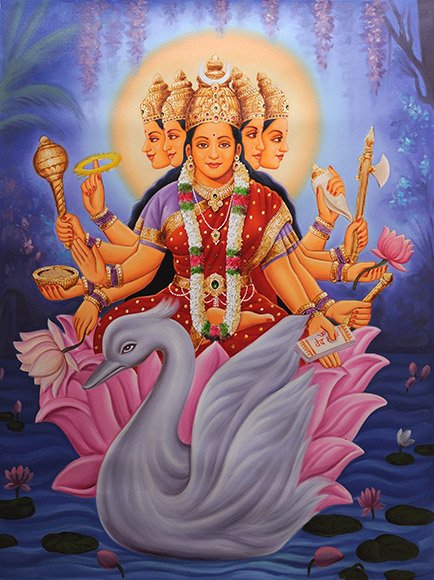Karahi, Karahī, Karāhī: 4 definitions
Introduction:
Karahi means something in Hinduism, Sanskrit, Buddhism, Pali, biology. If you want to know the exact meaning, history, etymology or English translation of this term then check out the descriptions on this page. Add your comment or reference to a book if you want to contribute to this summary article.
In Hinduism
Chandas (prosody, study of Sanskrit metres)
Source: Journal of the University of Bombay Volume II: Apabhramsa metres (1)1) Karahī (करही) refers to a variety of Mātrā: the only metre consisting of five lines, as discussed in books such as the Chandonuśāsana, Kavidarpaṇa, Vṛttajātisamuccaya and Svayambhūchandas.—Mātrā seems to be a very old Apabhraṃśa metre since it was known to Virahāṅka (see Vṛttajātisamuccaya) who describes four different varieties [viz., Karahī].—Mātrā (and thus Karahī) is an Ardhasama metre and contains five pādas. The uneven pādas contain 13 mātrās and the even ones have 11, mātrās. [...] Piṅgala discusses the Mātrā metre under Raḍḍā, and gives seven varieties of it [viz., Karahī: 13,11,13,11,13).
2) Karahī (करही) is another variety of Raḍḍā or Mātrā.—Piṅgala discusses [the Mātrā metre] under Raḍḍā, and gives seven varieties of it [viz., Karahī, consisting of the following mātrās: 13,11,13,11,13].

Chandas (छन्दस्) refers to Sanskrit prosody and represents one of the six Vedangas (auxiliary disciplines belonging to the study of the Vedas). The science of prosody (chandas-shastra) focusses on the study of the poetic meters such as the commonly known twenty-six metres mentioned by Pingalas.
Biology (plants and animals)
Source: Wisdom Library: Local Names of Plants and DrugsKarahi [कराही] in the Nepali language is the name of a plant identified with Albizia procera Albizia procera (Roxb.) Benth. from the Mimosaceae (Touch-me-not) family. For the possible medicinal usage of karahi, you can check this page for potential sources and references, although be aware that any some or none of the side-effects may not be mentioned here, wether they be harmful or beneficial to health.
Source: Google Books: CRC World Dictionary (Regional names)1) Karahi in India is the name of a plant defined with Albizia procera in various botanical sources. This page contains potential references in Ayurveda, modern medicine, and other folk traditions or local practices It has the synonym Mimosa elata Roxb. (among others).
2) Karahi is also identified with Ocimum basilicum It has the synonym Plectranthus barrelieri (Roth) Spreng. (etc.).
Example references for further research on medicinal uses or toxicity (see latin names for full list):
· Prodromus Systematis Naturalis Regni Vegetabilis (DC.) (1848)
· Novae Plantarum Species praesertim Indiae Orientalis (1821)
· Journal of the Linnean Society, Botany (1962)
· The Gardeners Dictionary (1754)
· Species Plantarum (1753)
· Flora Capensis, being a systematic description of the plants of the Cape Colony, Caffraria, & port Natal (Harvey) (1910)
If you are looking for specific details regarding Karahi, for example extract dosage, pregnancy safety, side effects, chemical composition, health benefits, diet and recipes, have a look at these references.

This sections includes definitions from the five kingdoms of living things: Animals, Plants, Fungi, Protists and Monera. It will include both the official binomial nomenclature (scientific names usually in Latin) as well as regional spellings and variants.
Languages of India and abroad
Pali-English dictionary
Source: Sutta: The Pali Text Society's Pali-English DictionaryKarahi, (Sk. karhi, when? kar=Loc. of pron. st. *quo= Lat. cur why, Goth. hvar, E. where), only in karaha-ci (karhi cid) at some time, generally preceded by kadāci D. I, 17; II, 139; M. I, 177, 454; A. I, 179; IV, 101; Miln. 73, 76. (Page 196)

Pali is the language of the Tipiṭaka, which is the sacred canon of Theravāda Buddhism and contains much of the Buddha’s speech. Closeley related to Sanskrit, both languages are used interchangeably between religions.
See also (Relevant definitions)
Starts with: Karahiya.
Relevant text
Search found 1 books and stories containing Karahi, Karahī, Karāhī; (plurals include: Karahis, Karahīs, Karāhīs). You can also click to the full overview containing English textual excerpts. Below are direct links for the most relevant articles:
Settlement in Early Historic Ganga Plain (by Chirantani Das)
Part 10 - Cultural periods of Vārāṇasī < [Chapter VI - Vārāṇasī: Emergence of the Urban Centre and Seat of Administration]